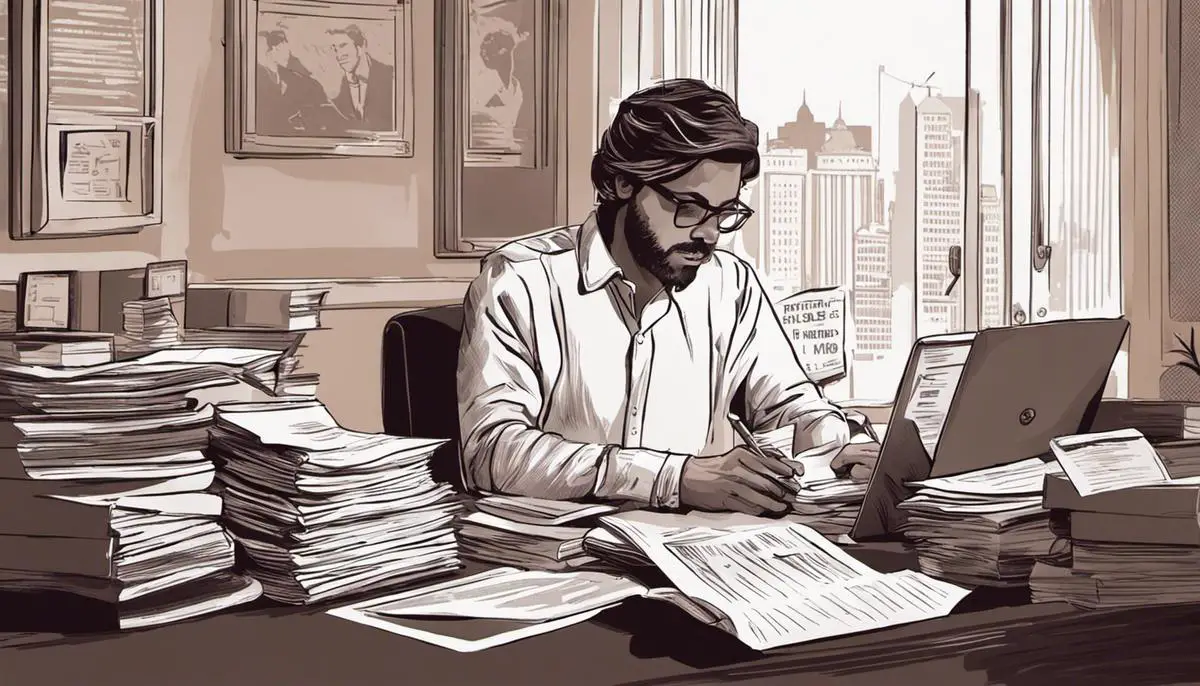As the world is swiftly becoming more digital and connected, the realm of freelancing is simultaneously expanding and evolving. A significant part of this new landscape is understanding the dynamics of royalties and licensing as it pertains to freelance income. These are critical elements that can greatly affect income, legal security, and control over creative work.
We’ll go through the intrigues of royalties and licensing as they provide an often vital revenue source for many freelancers. We aim to dissect their basics, discuss the financial and legal implications they carry, and ultimately guide freelancers towards strategic planning to massage the most advantage out of these agreements.
Basics of Royalties and Licensing for Freelancers
Understanding Royalties and Licensing for Freelancers
Royalties refer to the payment that a copyright or patent holder receives for the right to use their property. It is the compensation paid to the content creator or copyright holder when their work is used by others. These payments are typically agreed upon as a part of a contract and occur periodically, often based on the number of units sold or a percentage of income generated from the use of the copyrighted material.
Why Royalties and Licensing are important for Freelancers
Freelancers often create original works that can potentially generate continuous financial returns through royalties and licensing. For example, a freelance author may sell their book directly to consumers and earn a royalty on each sale. Alternatively, they may license the rights to publish the book to a publishing firm and receive regular licensing fees.
Similarly, a freelance artist or graphic designer might create an image, logo, or other design work that businesses wish to use. The artist can then license the use of this design to the business for a fee, while retaining ownership of the original work.
Various creative professional fields such as music, literature, performing arts, photography, software programming, and many more, can significantly benefit from understanding and negotiating fair royalty and licensing agreements.
Different types of Licensing Agreements
Freelancers may encounter a variety of licensing contracts, which may differ based on factors such as the licensor’s control over the work, the duration of the agreement, and the territory where the licensee is permitted to use the work.
Exclusive licenses grant the licensee the sole right to use, produce, and sell the copyrighted work within a specific region or product category. Non-exclusive licenses allow the licensor to grant the same or similar rights to more than one licensee.
In perpetuity licenses allow the licensee to use the copyrighted material forever, while term licenses only grant rights for a limited, specified time.
Royalty Agreement Essentials
A royalty agreement specifies how much a freelancer will be paid for the use of their copyrighted or patented work. This agreement outlines the basis on which royalties will be calculated and paid. For instance, the agreement might specify a percentage of the revenue generated from the sale of each product or service using the copyrighted work.
Royalty agreements often include terms that require regular auditing to verify sales or revenue amounts, protect the quality and reputation of the copyrighted work, and ensure that both parties understand and agree to their responsibilities.
For freelancers, navigating the realm of licensing and royalty agreements is imperative in order to secure adequate compensation and retain satisfactory control over their artistic productions. Before entering into these often-complex agreements, freelancers would be well-advised to seek the counsel of a legal representative or agent who is well-versed in these particular matters.

How royalties and licensing can impact a freelancer’s income
Understanding the Monetary Influence of Royalties and Licensing for Freelancers
Royalties and licensing can serve as indispensable financial lifelines for freelancers, providing not only a direct source of income but also potential for continuous earnings. Upon selling or licensing their creative output, freelancers typically negotiate an upfront fee. Beyond this immediate payment, licensing agreements may afford freelancers the opportunity for ongoing royalties, calculated commonly as a slice of the revenue pie their work helps to create. This leads to a sustainable income flow, persisting long after the work has been completed.
To illustrate, consider a freelance photographer who licenses their captures to a website. Every time a client pays to download a photograph, the photographer earns a royalty. Similarly, a freelance author producing material for a textbook may procure a royalty with every sale. Likewise, a freelance software developer can reap a royalty each time their app is downloaded.
Negotiating Royalties and Licenses for Freelancers
One key aspect of leveraging royalties and licenses for income involves successful negotiation. Usually, clients or companies might propose a licensing agreement or royalties arrangement. But, it’s up to the freelancer to negotiate the details.
There are several factors to consider when negotiating licensing agreements and royalties. First, freelancers must understand the potential value of their work. Researching similar deals in their industry can give freelancers a benchmark.
Second, freelancers must determine their desired level of involvement. With some licenses, the freelancer gives up all control over how the work is used, while with others, the freelancer might retain some control or approval rights.
Third, freelancers must determine whether the license is exclusive or non-exclusive. In an exclusive license, only the person or company given the license can use the work while a non-exclusive license allows freelancers to license their work to multiple parties, often leading to a higher potential income.
Case Studies: Understanding Real-Life Scenarios
A clear understanding of how royalties and licenses affect freelancers can be gained from real-life examples. For instance, J.K. Rowling, the author of the Harry Potter books, didn’t just sell her manuscripts but licensed the content for movies, merchandise, and theme parks. Though not a typical freelancer, this shows how a single work can translate to several income streams through licensing.
On a smaller scale, consider a freelance designer who creates a unique graphic print. They license this design to a clothing company and negotiate a royalty fee for every item sold with their design. These earnings are passive and keep generating income even after the initial work has been done.
Leveraging Royalties and Licensing as a Freelancer
As a freelancer, fully understanding and leveraging royalties and licensing can substantially boost your earnings. These additional, often passive income streams, have the potential to be extremely profitable. Becoming informed on the workings of royalties and licensing, coupled with learning how to successfully negotiate such arrangements, enables freelancers to capitalize on these financial prospects.

Legal implications of royalties and licensing
Decoding Licensing Agreements: Their Terms and Conditions
For freelancers, a sound understanding of licensing agreements is indispensable. These legal agreements are drawn between a licensor (client or company) and a licensee (freelancer), wherein the licensee is afforded the right to employ specific assets, such as artwork, music, software, or other intellectual property under terms and conditions detailed in the agreement. Essential components of a licensing agreement encompass the granting clause, obligations of both licensee and licensor, payment specifics, and termination provisions. Understanding these aspects in-depth, covering permitted applications, restrictions, royalties, and the validity of the license will aid freelancers in avoiding potential legal issues.
Copyright Law: Building a Protective Shield
Copyright law is one of the most critical legal areas for freelancers to understand. It’s the law that grants creators the exclusive right to use, reproduce, and distribute their original works. This protection is automatic upon the creation of a work, but it can also be legally registered for more solid protection. For freelancers, copyright law is the first line of defense in protecting one’s work from unauthorized use.
Entangling with Legal Issues: What Can Go Wrong?
There are several potential legal issues related to licensing and royalties. Overstepping the boundaries of a licensing agreement can lead to contractual disputes, which could result in termination of the agreement or even legal action. Infringement of copyright law is another major concern, and freelancers are often unaware of such infringements. This can lead to significant legal battles and monetary damages.
The Effect of Infringements: Significant Consequences
Infringing on licensing agreements or copyright could have serious consequences. In terms of monetary penalties, freelancers could be ordered to pay the actual dollar amount of damages and profits. The law provides a range from $200 to $150,000 for each work infringed upon. Legal fees and costs can also be significant. In some instances, criminal charges, including imprisonment, are a possible outcome.
Paving the Way to Secure Your Rights
Embarking on a freelance journey includes an obligation to safeguard your rights. First and foremost, it is crucial to thoroughly understand the ins and outs of any licensing agreement prior to accepting the terms. Understanding the permissible uses and the scope of the rights being conferred is essential. Moreover, it’s fundamental to assert your copyrights.
Having your copyright registered lends legal credibility to your ownership claim, which can prove useful in infringement disputes. Lastly, liability insurance is a wise investment for covering any potential legal expenses related to defending against copyright infringement and violations of licensing agreements.

Developing a strategy for licensing and royalties
Grasping the Concept of Royalties and Licensing
Royalties denote the earnings a person or an entity, such as a freelancer, acquires from the utilization of their creative or intellectual output. These can come from a wide array of sources including music, literary works, patents, as well as digital content.
On the other hand, licensing is the formal procedure by which the owner of any product, service, or intellectual property approves its usage to another entity. A licensing agreement usually takes the form of a contract that clarifies the terms of use, length of validity, and the accompanying monetary conditions associated with the licensing.
Maintaining Control Over Your Work
It is crucial for freelancers to maintain control over their work in any licensing agreement or royalty arrangement. This often involves specifying in the contract how and where the work can be used, setting limits on exclusivity, stipulating duration, and asserting the rights to revoke the license if certain conditions are not met. Restricting the license to non-exclusive can also allow freelancers to license their work to different clients simultaneously. Remember, giving up control over your work can potentially limit future revenue.
Finding the Right Business Partners
Part of the strategy involves identifying the right business partners. As a freelancer, you need to be careful about whom you choose to license your work to. Factors to consider include the potential partner’s reach, their reputation, the profitability of their business, and their history with freelancers. Conducting thorough research and possibly seeking legal or professional advice can be beneficial in finding reliable partners.
Understanding Fair Treatment in Licensing Agreements and Royalty Arrangements
In a licensing agreement, fair treatment often means that the freelancer receives a fair monetary compensation for the use of their work. In a royalty arrangement, the freelancer should receive a decent percentage of the profits from their work’s sale or use. It is essential to negotiate these terms before finalizing the agreement. Further, the terms stipulated in the contract should protect the interests of the freelancer. For instance, it’s important to have clearly defined terms about payment timelines, recourse in the event of non-payment, and mechanisms to resolve possible disputes.
Negotiating Compensation: Royalties vs. Flat Fee
In some instances, licensing arrangements may offer a flat fee option, or a one-time payment, rather than royalties. The choice between these two compensation models often depends on the nature of the work and the market conditions. While flat-fee arrangements are simple and provide immediate cash flow, they might not be the best choice for works with significant market longevity potential. On the other hand, royalty arrangements can provide an ongoing income stream, but this requires accurate reporting and income tracking.
Legal Considerations
Finally, freelancers must be aware of their legal rights and responsibilities when dealing with licensing and royalties. This includes understanding copyright laws, patent laws, and intellectual property rights. These laws vary across states and countries, hence obtaining legal advice might be necessary.
Moreover, freelancers should understand the common contract clauses, such as indemnity clauses, non-disclosure agreements, warranty clauses, and termination clauses. Understanding these will ensure that you are aware of your obligations and protect your work and economic interests in the long run.

The ability to navigate the complex terrain of royalties and licensing can prove the difference between a flourishing freelancer and one constantly at odds with the business side of their creativity. It is our hope that with the insights provided, freelancers can leverage a critical understanding of these elements to protect their work and maximize their income.
Remember, the goal is not just to survive in the freelancing world; but to thrive, prosper and maintain control over your creative output. Ultimately, knowing the ins and outs of royalties and licensing can prove an invaluable tool in ensuring fair treatment and securing a more fortunate and profitable freelance journey.



